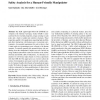Free Online Productivity Tools
i2Speak
i2Symbol
i2OCR
iTex2Img
iWeb2Print
iWeb2Shot
i2Type
iPdf2Split
iPdf2Merge
i2Bopomofo
i2Arabic
i2Style
i2Image
i2PDF
iLatex2Rtf
Sci2ools
131
Voted
IJSR
2010
2010
Safety Analysis for a Human-Friendly Manipulator
Abstract The DLR Lightweight Robot III (LWR-III) developed at the German Aerospace Center (DLR) is characterized by low inertial properties, torque sensing in each joint, and a load to weight ratio similar to humans. These properties qualify it for applications requiring high mobility and direct interaction with human users or uncertain environments. An essential requirement for such a robot is that it must under no circumstances pose a threat to the human operator. To actually quantify the potential injury risk emanating from the manipulator, impact test were carried out using standard automobile crash-test facilities at the ADAC (German automobile club). Furthermore, we introduce our analysis for soft-tissue injury based on swine experiments with the LWR-III. This paper gives an overview about the variety of investigations necessary to provide a safety analysis of a human-friendly robot based on biomechanical injury results. We believe this paper can provide a guideline for the robot...
Related Content
| Added | 18 May 2011 |
| Updated | 18 May 2011 |
| Type | Journal |
| Year | 2010 |
| Where | IJSR |
| Authors | Sami Haddadin, Alin Albu-Schäffer, Gerd Hirzinger |
Comments (0)

